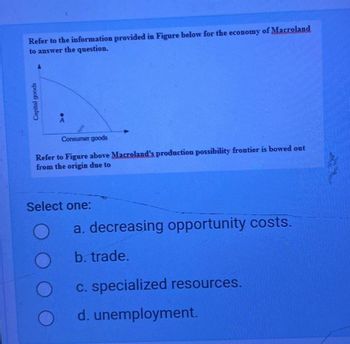
ENGR.ECONOMIC ANALYSIS
14th Edition
ISBN: 9780190931919
Author: NEWNAN
Publisher: Oxford University Press
expand_more
expand_more
format_list_bulleted
Question

Transcribed Image Text:Refer to the information provided in Figure below for the economy of Macroland
to answer the question.
Capital goods
A
Consumer goods
Refer to Figure above Macroland's production possibility frontier is bowed out
from the origin due to
Select one:
a. decreasing opportunity costs.
b. trade.
c. specialized resources.
d. unemployment.
Expert Solution
This question has been solved!
Explore an expertly crafted, step-by-step solution for a thorough understanding of key concepts.
This is a popular solution
Trending nowThis is a popular solution!
Step by stepSolved in 3 steps

Knowledge Booster
Learn more about
Need a deep-dive on the concept behind this application? Look no further. Learn more about this topic, economics and related others by exploring similar questions and additional content below.Similar questions
- use the following scenario to answer the following quation : an economy has a two workers smith and ricardo. each day theywork .smith can produce 4 computers and 16 smartephone. and ricardo can producce 6 computers and 12 smartphones. (1) the opppertunity cost for smith to produce one computer is ......... smart phones. (a) one quater of (b) one half of (c) one (d) two (e) fourarrow_forwardTable 1 Berries (Ibs.) Fish Rob 25 60 Bill 40 80 Rob Crusoe and Bill Friday spent their week-long vacation on a desert island where they had to find and make their own food. Rob and Bill spent one day each fishing and picking berries. The tables lists the pounds of output Rob and Bill produced.arrow_forwardAnd since we're giving up some of one good, does that mean the opportunity cost is a negative number? Josie Well, we don't often say that "it cost us negative two dollars" or "we gave up negative two units of something," right? We just say "it cost two dollars" or "we gave up two units." Sabrina Yeah, the "we gave up" or "it cost us" part kind of implies the negative, doesn't it? Josie Exactly! So we put opportunity cost in terms of absolute value - we get rid of the negative sign. Continue Sabrina Okay, so what is the opportunity cost of one cake if we move from combination A to combination B? (If needed, round to two decimal places.) PPF PPF Point A B C D E Y2 Y1 O Number of Cookies 37 35 29 20 0 X1 X2 Number of Cakes 0 4 7 9 10 D X3 X4 E → Cakesarrow_forward
- Don't use chatgpt or chatgpt-4 or other ai tool. If you know correct answer then attempt if you gave wrong answer I will give 5 dislikes and more from my friends account.arrow_forwardBeth can read 30 pages of astronomy in an hour. She can also read 20 pages of sociology in an hour. She spends 6 hours per day studying. **Use the blue line (circle symbol) to draw Beth's production possibilities frontier (PPF) for reading astronomy and sociology. Diagram has Astronomy Pages on the left from 0-200 in increments of 20's On the bottom of the Diagram it lists Sociology Pages numbered the same fom 0-200 in increments of 20. Beth's opportunity cost of reading 60 pages of sociology is ___________ pages of astronomy.arrow_forwardCan the Production Possibilities Curve shift left? If not, explain why. If it can, explain what might cause this to happen.arrow_forward
- Please correct answerarrow_forwardConsider an economy with two producers, Sidney and Connor. Each allocates 8 hours per day between the production of chocolate and bananas. Given 8 hours of labour, Sidney can produce 80kg of chocolate or 16kg of bananas. Connor can produce either 2kg of chocolate or 4kg of bananas per hour. B) Introducing Trade i) Suppose production capacity does not change. Do we expect there to be trade between Sidney and Connor? Why or why not? ii) What are the bounds on the price of bananas (in terms of chocolate) if there is trade? In other words, what range must the price of bananas fall within? iii) Assume a price of 4. In other words, 1kg of bananas cost 4kg of chocolate. Explain why trade is likely to make both Sidney and Connor better off in this case.arrow_forwardIf the nation depicted in Table 2.2 is producing at combination E, the opportunity cost of producing the tenth unit of consumer good is: A 1 unit of capital good. B C D E zero unit of capital good. 6 units of capital goods. 4 units of capital goods. 10 units of capital goods. Given below is the production possibilities schedule for capital goods and consumer goods. Table 2.2 Production Possibilities Schedule Combination Capital Goods Consumer Goodsarrow_forward
arrow_back_ios
arrow_forward_ios
Recommended textbooks for you

 Principles of Economics (12th Edition)EconomicsISBN:9780134078779Author:Karl E. Case, Ray C. Fair, Sharon E. OsterPublisher:PEARSON
Principles of Economics (12th Edition)EconomicsISBN:9780134078779Author:Karl E. Case, Ray C. Fair, Sharon E. OsterPublisher:PEARSON Engineering Economy (17th Edition)EconomicsISBN:9780134870069Author:William G. Sullivan, Elin M. Wicks, C. Patrick KoellingPublisher:PEARSON
Engineering Economy (17th Edition)EconomicsISBN:9780134870069Author:William G. Sullivan, Elin M. Wicks, C. Patrick KoellingPublisher:PEARSON Principles of Economics (MindTap Course List)EconomicsISBN:9781305585126Author:N. Gregory MankiwPublisher:Cengage Learning
Principles of Economics (MindTap Course List)EconomicsISBN:9781305585126Author:N. Gregory MankiwPublisher:Cengage Learning Managerial Economics: A Problem Solving ApproachEconomicsISBN:9781337106665Author:Luke M. Froeb, Brian T. McCann, Michael R. Ward, Mike ShorPublisher:Cengage Learning
Managerial Economics: A Problem Solving ApproachEconomicsISBN:9781337106665Author:Luke M. Froeb, Brian T. McCann, Michael R. Ward, Mike ShorPublisher:Cengage Learning Managerial Economics & Business Strategy (Mcgraw-...EconomicsISBN:9781259290619Author:Michael Baye, Jeff PrincePublisher:McGraw-Hill Education
Managerial Economics & Business Strategy (Mcgraw-...EconomicsISBN:9781259290619Author:Michael Baye, Jeff PrincePublisher:McGraw-Hill Education


Principles of Economics (12th Edition)
Economics
ISBN:9780134078779
Author:Karl E. Case, Ray C. Fair, Sharon E. Oster
Publisher:PEARSON

Engineering Economy (17th Edition)
Economics
ISBN:9780134870069
Author:William G. Sullivan, Elin M. Wicks, C. Patrick Koelling
Publisher:PEARSON

Principles of Economics (MindTap Course List)
Economics
ISBN:9781305585126
Author:N. Gregory Mankiw
Publisher:Cengage Learning

Managerial Economics: A Problem Solving Approach
Economics
ISBN:9781337106665
Author:Luke M. Froeb, Brian T. McCann, Michael R. Ward, Mike Shor
Publisher:Cengage Learning

Managerial Economics & Business Strategy (Mcgraw-...
Economics
ISBN:9781259290619
Author:Michael Baye, Jeff Prince
Publisher:McGraw-Hill Education